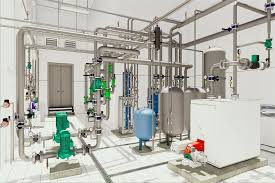In the realm of construction and infrastructure development, the integration and management of Mechanical, Electrical, and Plumbing (MEP) services stand as pivotal elements. These systems not only ensure functionality but also significantly impact the efficiency and sustainability of buildings and structures.
Understanding the Significance of MEP Solutions
MEP systems serve as the lifeline of any infrastructure, providing essential services for habitability, comfort, safety, and functionality. Managing these systems efficiently is key to optimizing operational efficiency and reducing long-term operational costs.
Integrated Approach to Design and Planning
Effective management of MEP solutions begins at the design and planning stage. Embracing an integrated approach that considers MEP services from the project's inception ensures seamless integration into the overall design, minimizing conflicts and maximizing efficiency.
Energy-Efficient Design and Sustainability
MEP solutions play a critical role in achieving sustainability goals. Implementing energy-efficient technologies, optimizing HVAC systems, utilizing renewable energy sources, and incorporating water-saving fixtures contribute to environmentally responsible infrastructure.
Technological Advancements in MEP Systems
Advancements in technology have revolutionized MEP solutions. From smart building automation to energy management systems, leveraging technology enhances the efficiency and performance of MEP systems, reducing waste and improving overall functionality.
Effective Project Management and Coordination
Efficient project management is integral to successful MEP solutions. Coordinating between various stakeholders, managing timelines, and ensuring quality control during installation and maintenance are crucial for seamless MEP integration.
Risk Mitigation and Quality Assurance
Managing MEP solutions involves mitigating risks and ensuring quality throughout the project lifecycle. Rigorous testing, inspections, and compliance with industry standards safeguard against operational failures and ensure optimal performance.
Maintenance and Lifecycle Management
Proactive maintenance and lifecycle management of MEP systems are vital. Establishing regular maintenance schedules, predictive maintenance using IoT sensors, and lifecycle assessments prolong system longevity and optimize operational efficiency.
Training and Skilled Workforce Development
Investing in a skilled workforce and continuous training is essential for managing MEP services effectively. Well-trained personnel equipped with the latest knowledge and skills contribute significantly to efficient system operations.
Adaptability and Future-Proofing Infrastructure
In a rapidly evolving technological landscape, future-proofing infrastructure through adaptable MEP solutions is critical. Designing systems that can accommodate technological advancements ensures infrastructure remains relevant and efficient over time.
Advanced Building Automation Systems
Modern MEP solutions are increasingly reliant on sophisticated building automation systems. These systems, powered by IoT (Internet of Things) devices and smart sensors, enable real-time monitoring, predictive maintenance, and remote control of MEP systems. Implementing these advanced technologies optimizes energy consumption and enhances operational efficiency.
Optimization through Data Analytics
Data analytics plays a pivotal role in managing MEP solutions. Analyzing data collected from building management systems helps identify patterns, predict potential system failures, and optimize energy usage. This proactive approach aids in fine-tuning MEP systems for optimal performance.
Sustainable HVAC Solutions
Heating, Ventilation, and Air Conditioning (HVAC) systems are major energy consumers in buildings. Implementing sustainable HVAC solutions, such as energy-efficient equipment, zone-based controls, and heat recovery systems, significantly reduces energy consumption while maintaining occupant comfort.
Water Conservation Techniques
MEP solutions extend beyond energy management to include water conservation techniques. Installing water-efficient fixtures, implementing rainwater harvesting systems, and employing greywater recycling methods contribute to sustainable water management within buildings.
Collaborative Project Management
Collaboration among various stakeholders is essential for successful MEP solutions. Effective communication, coordination, and collaboration between architects, engineers, contractors, and facility managers streamline the design, installation, and maintenance of MEP systems, ensuring efficiency throughout the project lifecycle.
Regulatory Compliance and Green Certifications
Adhering to regulatory standards and obtaining green certifications, such as LEED (Leadership in Energy and Environmental Design), underscores the commitment to sustainable MEP services. Compliance ensures that MEP systems meet environmental standards while green certifications validate their sustainability credentials.
Continuous Improvement and Innovation
Embracing a culture of continuous improvement fosters innovation in managing MEP solutions. Encouraging feedback loops, implementing lessons learned from previous projects, and staying updated on emerging technologies drive the evolution of more efficient and sustainable MEP systems.
Life-Cycle Cost Analysis
Conducting life-cycle cost analyses for MEP systems evaluates the total cost of ownership over the system's lifespan. Assessing initial costs, operational expenses, maintenance, and energy consumption aids in making informed decisions that prioritize long-term efficiency and cost-effectiveness.
User Education and Engagement
Engaging building occupants through educational programs about efficient energy and water usage fosters a culture of sustainability. Educated users play a vital role in optimizing MEP systems by understanding and utilizing building systems efficiently.
Strategic Planning for Resilience
Planning for resilience involves preparing MEP systems to withstand unforeseen challenges, such as extreme weather events or technological disruptions. Incorporating redundancy, backup systems, and robust contingency plans ensures continuity in operations despite potential disruptions.
Conclusion
Managing MEP services requires a holistic approach that encompasses design, implementation, maintenance, and continuous improvement. Embracing technological advancements, sustainable practices, efficient project management, and skilled workforce development ensures optimal infrastructure efficiency and functionality.ENGISOFT ENGINEERING - BIM Staffing & BIM Services This comprehensive blog highlights the strategies and significance of managing MEP solutions to enhance infrastructure efficiency, focusing on sustainable practices, technological advancements, and effective project management in ensuring optimal system performance.


No comments yet